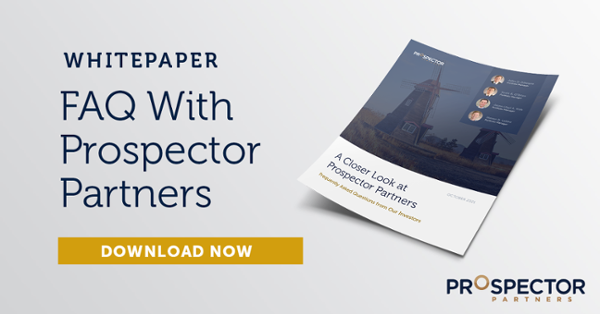A question we’re often asked is how, given our consistent focus on the financial sector, we've historically been able to achieve differentiated returns during periods of acute stress in the banking system. There are several factors behind our track record, all of which are a product of our conservative and value-driven approach to investing. As we discussed in A Spotlight on Under-the-Radar Financials, Part 1, there is significant heterogeneity in the financial sector with respect to leverage, responses to changes in interest rates, and sensitivities to broad-based economic cycles. Our strategy is not driven by sector benchmarks, which can be disproportionately weighted to highly cyclical, large-cap money centers, and instead emphasizes companies with differentiated business models and more idiosyncratic risk profiles.
In this blog we’ll take a look at the insurance industry, another unglamorous component of the financial sector that fails to get as much attention from Wall Street as one would expect from an industry that collects roughly $7 trillion in premiums annually.
While everyone uses insurance, relatively few realize how attractive insurance companies can be from an investment standpoint.
As is the case with regional banks, this oversight presents us with a greater number of alpha-generating opportunities compared to the more crowded and fashionable areas of the equity market.
Within the insurance sector, we continue to devote resources to both life insurance and property & casualty, the two broad segments of the industry which happen to have very different economics. Life insurance companies, on the one hand, sell a wide range of products, from the relatively simple (e.g., term life policies) to the relatively complicated (e.g. annuities, and other products combining death benefits, investment returns, and a variety of bells and whistles to meet individual financial and estate planning needs). Life insurance products are fairly commoditized, and differentiation comes from distribution, cost advantages, brand, and various other attributes. In general, life insurers focused on simpler products tend to have the qualities we look for: captive distribution, cost advantages, and lower capital requirements. In addition, the less complicated companies typically don’t have to stretch for yield, and they produce less reserve and accounting variability. While life insurance companies and banks are often the most highly leveraged names in the financial sector, we have a strong bias towards owning the least levered members of the group.
Property & casualty insurance, on the other hand, tends to be the least economically sensitive financial sector. That said, P&C is cyclical and diverse, and there are significant differences, for example, between insurance for cars and homes as opposed to businesses and employees. The range of profiles stems from the predictability and variability of losses, the duration of claims payments, and how much leverage regulators allow. Looking at P&C as a whole, we often describe the group's accounting as a self-graded exam: companies take in premiums well before their cost of goods sold is known, and at the same time set up reserves for future losses when they take in the premiums. This often creates situations where two companies may appear the same based on valuation, but by looking more closely we can determine that one has been more aggressive on establishing the liabilities for future losses (i.e., setting aside too little for reserve) and is therefore over-stating earnings and shareholders’ equity.
At some point, the chickens come home to roost, and the under-reserved companies will have to take a hit to reserves as the paid claims start coming in much higher than their initial estimates.
The insurance industry also holds a special place in our hearts as one of our original investors, Jack Byrne, was a magnate in the industry, made famous for his turnaround of GEICO and partnership with Berkshire Hathaway. Jack was also a mentor to our founding partner, John Gillespie. In fact, when Prospector was founded, Jack’s core insurance business principles turned into Prospector’s core investment tenets:
- “Underwriting comes first” became “Bottom-up company analysis comes first.”
- “Maintain a disciplined balance sheet” became “Maintain a disciplined, low leverage portfolio construction.”
- “Invest for total return” became “Invest for total return after tax.”
- “Think like an owner” became “Eat our own cooking and invest side by side with our clients.”
By sticking to these principles, and ignoring the herd mentality that dictates benchmark construction, we’ve consistently been able to deliver differentiated returns within our financials holdings during times the sector as a whole appears to be challenged. With more uncertainty undoubtedly ahead, we’re able to sleep well knowing our portfolio is built on a strong foundation.
If you’d like to further understand our fundamental approach to analyzing insurance companies, please download our whitepaper, The Nuances of Insurance Investing.


